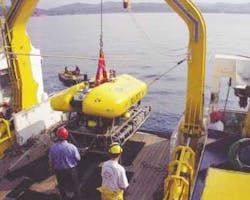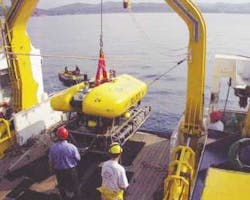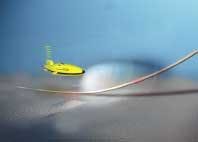Southern France engineering groups taking underwater vehicles into new territory
Jeremy Beckman
Editor, Europe
This year's Deep Offshore Technology conference will heavily focus on underwater vehicle technology. Henri-Germain Delauze, one of the most influential figures in subsea engineering in France, will deliver next month's keynote speech at DOT 2003. Delauze started out as a professional diver, and subsequently graduated to oceanography, leading scientific campaigns in the late 1950s and early '60s in manned deepwater submersibles into the great abyssal trenches off Japan, Greece, and Puerto Rico. In 1962, he established his own business, Compagnie Maritime d'Expertises (Comex) in Marseille, which pioneered deep saturation diving using synthetic breathing mixtures.
Comex's activities adapted and expanded as the E&P industry went into progressively deeper waters. In the early 1970s, the company worked with the Subsea Equipment Associated Ltd. (Seal) consortium that built and installed two of the world's first subsea production systems in the US Gulf of Mexico and the French Mediterranean.
In 1977, Comex introduced the first dynamically positioned (DP) semisubmersible dive support vessel (DSV), the Uncle John, designed by Houlder Offshore and Delauze. This was followed by three purpose-built DSVs, the Seabex (a Comex design), the Seacom, and the Ugland Comex I, all equipped with integrated saturation systems.
During 1982, Comex teamed up with Houlder and Stolt Nielsen Seaway to undertake tie-ins offshore Norway for what were the world's two deepest gas pipelines. Around this time, it also worked with Total and Elf to develop an ROV for diverless pipeline repairs in 1,000 m of water.
Following the subsequent decline in diving requirements, the offshore contracting subsidiary was sold to Stolt Nielsen in 1992 for $50 million, leading to the formation of Stolt Comex Seaway (known today as Stolt Offshore). But the Comex group has retained its links with the offshore sector – particularly in remotely operated and autonomous vehicles – through its subsidiary company Cybernetix. Today, the Comex Pro division continues to manufacture heavy equipment and hyperbaric facilities for deep diving. Comex's Janus catamaran provides support for offshore surveys. The group also has shares in specialist French offshore engineering groups Doris and Principia.
Principia is based in La Ciotat on the south coast, close to Cybernetix, while France's other underwater vehicle designers, ECA and Ifremer, are not far away in Toulon/La Seyne. Other niche subsea engineering companies in this region are the Oceanide test basin in La Seyne, Metravib (instrumentation) and the camera specialist Hytec, based in Montpellier. Subsea robotics equipment group GRSM formed to bring together private companies and academic institutions to further development of new technologies.
Some of these companies, led by Cybernetix, are promoting establishment of a Deep Water Trial Centre offshore Marseille/Toulon, where water depths dip quickly to 1,000-1,200 m. Cybernetix and ECA have already tested their own prototype vehicles in these waters. As Delauze points out, in Brest – France's other emerging center for offshore engineering – "You must go 200 miles west into the Atlantic if you want to do tests there in more than 200 m of water. France was one of the earliest centers of offshore activity, in 1965, and Marseille would be one of the best places to develop new deep and ultra-deepwater technologies. It has a reputation as a hard-working industrial city, and in addition to our various test centers, there are plenty of good engineering schools and universities nearby."
null
AUVs and ROVs for inspection, intervention
Early this year, Cybernetix moved its offshore robotics division from the outskirts of Marseille to larger premises at Comex's headquarters. Extra space was needed to work on an expanding range of underwater intervention and inspection tools. Two developments attracting special attention from deepwater operators are Alive, an autono-mous light intervention work vehicle, and Swimmer, a hybrid AUV/ROV designed for heavier duty inspection, repair, and maintenance tasks.
Alive is a three-year, five-partner ¤4.4-million project supported by the Euro-pean Commission. The aim is to produce a free-swimming vehicle that can navigate in water depths to 3,000 m and subsequently dock onto the ROV panel of a subsea structure, such as a christmas tree, using its telemanipulator arm to open and close valves or operate torque tools. The vehicle's seven-function SAMM manipulator operates in pre-programmed mode, with supervision from the surface via an acoustic modem. Unlike an ROV, the Alive will swim straight to its target without the need for a DP launch/support vessel or an ultra-long umbilical. It could be housed in the moonpool area of an FPSO or fixed to the vessel's side.
According to Cybernetix, docking with the subsea structure is automatically controlled onboard the vehicle via sophisticated video and sonar image processing, matched with a computer-aided design (CAD) file of the target. Once a match is obtained, the vehicle's two grabber claws latch onto the ROV panel. The operator, through the same process of matching CAD and video images, will also validate each subsequent turn of the valve by the pre-programmed telemanipulator.
"Although our system is pre-programmed," says Cybernetix's Pierre Marty, "there is also the possibility of live operator input for optimization. So if you dock on a panel, and you happen to be 5 cm out, as the Alive's manipulator arm starts to move towards the valve, the operator can intervene to tell it to go higher through the acoustic supervision link."
Cybernetix is the project coordinator, with Ifremer in nearby La Seyne sur Mer working on navigation and dynamic stabilization, Hitec Subsea in Norway on the man/machine interface, and Heriot-Watt University in Edinburgh, UK, on sonar and video image processing. The European Commission's Joint Research Centre in Ispra, Italy, is responsible for manipulator trials.
System integration was completed this March. A series of shallow-water tank tests have since validated each sub-system. Successful sea tests in early August validated the navigation and acoustic communication capabilities. Final sea trials are scheduled over two weeks at the end of October, with the objective of performing real interventions on a mock-up of an ROV panel.
Several major operators, notably BP and Statoil, and subsea equipment manufactures are monitoring developments.
"BP see this as the first step toward autono-mous interventions in deepwater," says Cyber-netix Offshore Division Manager Yves Chardard.
Subsea Work Inspection and Maintenance with Minimum Environment ROV (Swimmer) is closer to commercial application, having undergone deepwater trials off St. Tropez in October 2001. This concept is more complex than Alive, in that it comprises both an ROV and an AUV shuttle. But there are similar cost advantages, with again no need for a dedicated surface support vessel. Typi-cally, it is designed for routine, pre-planned intervention work on wellheads and manifolds. Cybernetix's partners in this project are Total, Ifremer, and the University of Liverpool.
In principle, the AUV shuttle is launched with the ROV mechanically attached. In transit to the sea floor, the shuttle operates like a normal AUV, traveling automatically to a pre-defined approach point. En route, the vehicle is monitored and controlled via a long-range acoustic bi-directional telemetry link, and a long baseline/dead-reckoning positioning system. Having stabilized itself 20-30 m above the targeted location, it subsequently lands vertically on a pre-installed docking station using a short-range sub-metric positioning system incorporating 3D sonar image processing.
Once the shuttle locks onto the docking station, the wet connectors mate, allowing the ROV to be powered and controlled through its pre-installed umbilical. The ROV is then released from the shuttle and operated remotely from the surface via an acoustic link, through a 100-m tether management system integrated into the shuttle.
The current shuttle prototype is 6.1 m long, 2.46 m wide, and 2.45 m high, with a weight of 4,785 kg. Three-phase asynchronous motors driven by frequency converters provide longitudinal, vertical, and transversal thrust. A high-density battery pack supplies power. Maximum relative forward speed is 1.5 kt, with an operational range of 10 km and autonomy at full speed up to 5 hr. The vehicle can operate in waters to 3,000 m deep, with a payload to 2,000 kg.
Earlier this year, Statoil commissioned a three-part study to define and cost the basic design of a Swimmer that would be fully compatible and integrated with Statoil's existing and future subsea installations. FMC Kongsberg Subsea is also involved. FKS has been working on subsea production systems with AUV-friendly tooling and connections for water depths down to 4,000 m.
The new study will define solutions for a next-generation Swimmer that will:
- Reduce on-site power needs to power the ROV through conventional umbilicals
- Modify the docking station to incorporate it directly into the subsea structure
- Scale back the intervention interfaces to allow the Swimmer to perform most intervention and IRM tasks associated with a typical subsea field in production.
Cybernetix also coordinates another pan-European initiative, Freesub, which is researching the problems of docking AUVs on subsea structures. Several of the partners are currently working on an AUV-friendly interface to simplify the docking procedure, through installation of special devices on existing ROV docking panels.
Another Cybernetix project that Total and Stolt Offshore are monitoring closely is Junior, a small observation ROV designed to be mounted aft or underneath a work class ROV in a tooling cage, then operated through the host ROV's umbilical. Junior would provide the pilot with a second "eye view" of an intervention operation through its motorized, low-light color video camera. Alternatively, it could fly around a wellhead or another area too congested for the Work ROV to operate in.
null
A prototype was fabricated this year measuring 50 cm long, 38.5 cm wide, and 22.7 cm high, with a dry weight of 25 kg, and a maximum payload of 3 kg. Aside from the camera, instrumentation includes a depth meter, an altitude meter, a fluxgate, and a six-axis motion measurement system. A DP system driven by five low-power-consumption thrusters provides stabilization of both the vehicle and its low light color video camera. Junior is rated for operations in 3,000-m water depth. The tool cage is 142 cm long, 50 cm wide, and 50 cm high, with a 50 m long tether, and a dry weight of 80 kg. It is also buoyant in water.
Other ongoing developments are:
- Spider, an all-electric, remotely-operated crawler for subsea pipeline inspections, now also being upgraded to work in autonomous mode in up to 1,500 m of water, performing tasks such as touchdown and pipelay monitoring. The vehicle is operated from a pipelay barge.
- MRP is an ROV-operated, pipeline tie-in metrology tool, which was first deployed in 1,350 m of water on the Girassol field. This comprises two modules linked by a twisted pair cable, each module being installed on the two flanges to be connected. A telemetry link relays to the ROV pilot data on the length and angles of the tie-in operation.
- Hyper, being developed in cooperation with Cenpes, the R&D arm of Petrobras, is a remotely-operated system designed to travel several miles inside a deepwater pipeline to destroy hydrate plugs. This is achieved using a "destruction head" designed to allow attachment of removal systems such as high-pressure heat/chemical injection nozzles.
Real-time pipelay monitoring
ECA, based in Toulon, has been working for several years on programs concerning AUVs for use in the offshore, scientific, and military sectors. Offshore, the company's R&D efforts have focused on the need to operate vehicles at great depth close to subsea installations. One of these programs, called Halidostar, is funded by local authorities in Bretagne, northwest France, and supported by the Haliod group of companies. The program aims to develop an AUV capable of performing all operations related to the inspection of underwater structures, in particular pipelines and umbilicals.
As project leader, ECA is combining its own expertise in underwater robotics with the acoustic communication, acoustics, and inertial positioning capabilities of its partners, and local technical institutes and universities in the Brest area. The 3,000-m depth engineering inspection AUV, the Alistar 3000, will be unveiled at DOT next month. Additionally, ECA will conduct a live demonstration simulating the monitoring of a typical pipelay operation at sea, using its 300-m AUV demonstrator facility.
The Alistar 3000 can be acoustically tracked so that the operator knows the precise position of the AUV at all times. Thereby, the operator can deduce the touchdown point (TDP) position and transmit this information to the lay barge, which in turn can adjust its motion to lay the pipe in the required corridor. The Alistar's onboard lithium/ion battery pack provides typical autonomy of 24 hours.
"Apart from knowing the position of the TDP, operators sometimes need to have additional information such as a video of the TDP area, checking for freespans," says Daniel Scourzic, ECA's director of Defense & Offshore. "To achieve this, we have integrated video and sonar imaging capabilities to our AUV, which can be pre-programmed to record the information. Alternatively, the operator can be trained to use acoustic communication to request the AUV to send back a video snapshot, or any other information it has retrieved."
Further applications under development include tasks such as periodic inspection of pipelines.
Another of the company's R&D programs concerns development of fuel cells, which could one day be used to power AUVs on extended missions or fixed installations on the seabed. The technology, called Hexapac, has been developed with Ifremer, and supported by the French Ministry of Trade & Industry.
ECA's version, which has successfully generated 2 KW in tests, is an anaerobic fuel cell, housed in a container, which employs pure hydrogen and oxygen, stored in highly pressurized tanks. The long-term aim is for the fuel cell to operate automatically, without human supervision.
"Future generations of AUVs will very likely be equipped with fuel cells in order to increase their autonomy," says ECA Commercial Director Jean-Pierre Hainsselin.
Shelf break, shipwreck surveys
Ifremer has worked on robotic systems for the offshore sector since 1979, developing manipulator arms and navigational aids and other types of survey equipment for large ROVs. Recent achievements include design of the docking system for the Swimmer and the data transmission link and optical DP system for the Alive.
All Ifremer's systems for scientific research purposes, e.g., the manned submersible Nautile with its small associated ROV, Robin, the Victor 6000 ROV, and various optical and acoustic deep towed vehicles, are designed for operations in 6,000-m water depth, a figure that takes in 97% of the earth's sea surface. These vehicles have also been used for offshore oil industry surveys on continental margins and for intervention work on sunken tankers, such as the Prestige in 2002-03, and on the RMS Titanic in 1997-98.
The Victor 6000, built in the late 1990s, was deployed in 2001 in studies offshore West Africa and the northeast Atlantic Margin from the French research vessel L'Atalante. The vehicle weighs 4,000 kg and can travel at speeds up to 1.5 knots.
For sampling, a 2.5 by 1.9 by 0.7 m tool sled, weighing 150 kg in water, can be fitted underneath the vehicle. This carries all devices required for sampling the water, by pumping the sediment with various corers, and for measuring temperature. Positioning of the vehicle is performed using the ultra short baseline system Posidonia, and the dead reckoning employs a fiber optic gyro, Octans.
Ifremer and then-TotalFinaElf mounted two missions in the Gulf of Guinea in January and November 2001. They were known as the Biozaire cruises 1 and 2, after a preliminary survey performed with Ifremer's multi-beam and deep-towed sonar, SAR. Here, the Victor 6000 was used for studies of the benthic fauna and the physical and chemical characteristics of the seafloor. The survey team's aims included detection of surface indices and establishing how these are related with hydrocarbon seeps in the passive margin.
New equipment tested on the Victor 6000 included a multi-beam sonar Reson Seabat 8101, for microbathymetry and acoustic imagery. The sonar generated very accurate maps of parts of two mounds, with evidence of ripple marks along the flanks related to higher faunal abundance. The Victor 6000 microbathymetry is now a proven option, having since been deployed on the Franco-German Polarstern expedition conducted on the Hakon Musby mud volcano, where methane gases are released through the sea floor.
Ifremer has completed over 3,000 dives with its manned submersibles, over 3,000 hr with the Victor 6000 alone, and over 20,000 km of surveys with its deep-towed vehicles and the Epaulard AUV.


